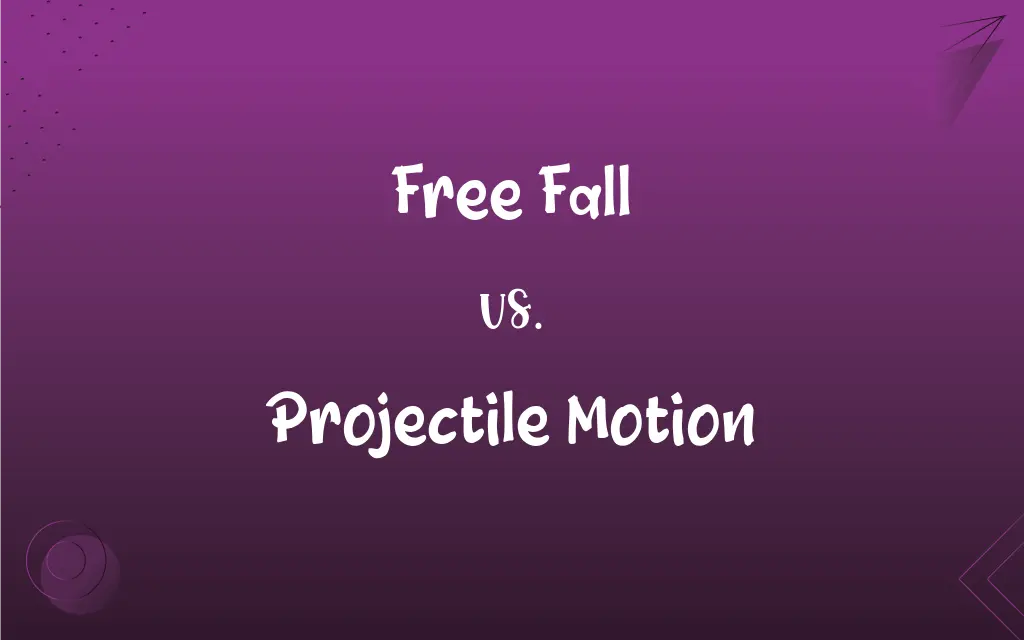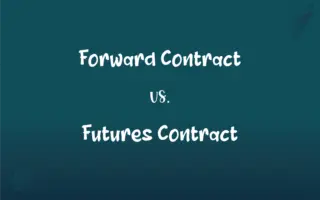Free Fall vs. Projectile Motion: What's the Difference?
Edited by Aimie Carlson || By Janet White || Published on February 5, 2024
Free fall is a motion under the influence of gravity only, without any initial horizontal velocity. Projectile motion is a motion of an object thrown or projected into the air, subject to gravity and initial velocity.

Key Differences
Free fall is a type of motion where an object moves under the influence of gravity alone, without any initial horizontal velocity. Projectile motion involves both a vertical component, like free fall, and a horizontal component due to initial velocity.
In free fall, the only force acting on the object is gravity, causing it to accelerate downwards. Projectile motion, however, is the result of an initial thrust or velocity, which gives the object a curved trajectory.
Objects in free fall experience acceleration due to gravity, typically 9.8 m/s², without any resistance or propulsion. In projectile motion, the object's horizontal velocity remains constant while the vertical component is affected by gravity.
Free fall occurs when an object is dropped from a height with no initial horizontal push. Projectile motion occurs when an object is thrown or propelled, like a ball being kicked or a bullet being fired.
The trajectory of a free-falling object is a straight line. In contrast, the trajectory of a projectile is parabolic due to its initial horizontal velocity and vertical acceleration.
ADVERTISEMENT
Comparison Chart
Initial Velocity
No initial horizontal velocity
Initial velocity in at least one direction
Forces Acting
Only gravity
Gravity and initial thrust or velocity
Trajectory
Straight line downwards
Parabolic due to combined vertical and horizontal motion
Velocity Components
Only vertical component changes
Both horizontal and vertical components
Typical Examples
Dropping an object from a height
Throwing a ball, firing a bullet
ADVERTISEMENT
Free Fall and Projectile Motion Definitions
Free Fall
Acceleration at 9.8 m/s² downwards due to gravity.
The stone accelerated in free fall after being dropped.
Projectile Motion
Motion caused by gravity and initial thrust or velocity.
The football followed a curved path due to projectile motion.
Free Fall
No air resistance acting on the falling object.
In a vacuum, all objects experience free fall at the same rate.
Projectile Motion
A parabolic trajectory combining vertical and horizontal movements.
The basketball displayed projectile motion as it arced towards the hoop.
Free Fall
Movement under gravity with no initial horizontal speed.
An apple falling from a tree is in free fall.
Projectile Motion
Starts with an initial velocity in at least one direction.
The arrow's projectile motion began with its release from the bow.
Free Fall
A straight-line downward trajectory.
The dropped ball's path was a straight line, indicating free fall.
Projectile Motion
Horizontal velocity remains constant; vertical velocity changes.
In projectile motion, the cannonball's horizontal speed stayed constant.
Free Fall
No propulsion or initial push.
In free fall, the object had no initial velocity other than gravity.
Projectile Motion
Influenced by factors like angle of projection and initial speed.
Changing the angle of projection altered the object's projectile motion.
Free Fall
Alternative spelling of freefall
Free Fall
Alternative spelling of freefall
FAQs
Does the mass of an object affect free fall?
In the absence of air resistance, mass does not affect the rate of free fall.
Is air resistance a factor in free fall?
In ideal free fall, air resistance is negligible.
What is the acceleration of an object in free fall?
Typically 9.8 m/s² downwards, due to gravity.
How does angle of projection affect projectile motion?
It determines the range and height of the trajectory.
Can projectile motion be horizontal?
Yes, if the initial velocity is purely horizontal.
What shapes the trajectory of projectile motion?
A combination of initial velocity and gravity forms a parabolic path.
What role does initial speed play in projectile motion?
It influences the distance and height reached by the projectile.
What is free fall?
Movement of an object solely under the influence of gravity.
Is terminal velocity a concept in free fall?
Yes, it's the maximum velocity reached when air resistance equals gravitational force.
What defines projectile motion?
Motion with both vertical and horizontal components due to gravity and initial velocity.
Are satellites in free fall?
Yes, they are in continuous free fall around the Earth.
Does wind affect projectile motion?
Yes, wind can alter the trajectory of a projectile.
What factors can alter projectile motion?
Initial speed, angle of projection, and air resistance.
Can projectile motion occur without gravity?
No, gravity is essential for creating the parabolic path.
Can free fall occur in a vacuum?
Yes, free fall in a vacuum is unaffected by air resistance.
Is free fall possible on the Moon?
Yes, but with a lower acceleration due to the Moon's weaker gravity.
Do objects of different weights fall at the same rate in free fall?
In the absence of air resistance, they fall at the same rate.
What is the velocity of an object at the peak of its free fall?
At the peak, vertical velocity is zero before it starts falling back.
How does height of release affect projectile motion?
It can impact the time of flight and distance traveled.
Does the size of an object affect its projectile motion?
Not directly, but air resistance can have more effect on larger objects.
About Author
Written by
Janet WhiteJanet White has been an esteemed writer and blogger for Difference Wiki. Holding a Master's degree in Science and Medical Journalism from the prestigious Boston University, she has consistently demonstrated her expertise and passion for her field. When she's not immersed in her work, Janet relishes her time exercising, delving into a good book, and cherishing moments with friends and family.
Edited by
Aimie CarlsonAimie Carlson, holding a master's degree in English literature, is a fervent English language enthusiast. She lends her writing talents to Difference Wiki, a prominent website that specializes in comparisons, offering readers insightful analyses that both captivate and inform.







































































